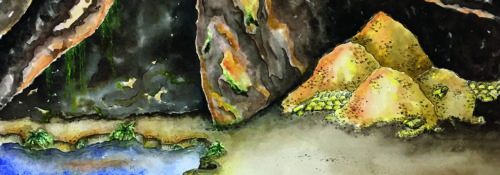
The Real Treasure in Robert Louis Stevenson’s Treasure Island
 Robert Louis Stevenson’s classic novel, Treasure Island, unearths a world of seafaring adventures complete with a cast of ragamuffin pirates, English gentlemen, and an adolescent boy thrust into a situation that will force him to choose the type of man he wishes to become. Furthermore, the language of the sea that Stevenson so aptly conveyed in the novel set the standard for the pirate story genre that still enjoys immense popularity. The book’s length and vast descriptions may be daunting for elementary-age readers. However, with a teacher’s guidance, students can successfully put themselves in the lead character Jim’s shoes as they embark on a quest for the treasures of Treasure Island, according to Professor of Education Dan Coupland.
Robert Louis Stevenson’s classic novel, Treasure Island, unearths a world of seafaring adventures complete with a cast of ragamuffin pirates, English gentlemen, and an adolescent boy thrust into a situation that will force him to choose the type of man he wishes to become. Furthermore, the language of the sea that Stevenson so aptly conveyed in the novel set the standard for the pirate story genre that still enjoys immense popularity. The book’s length and vast descriptions may be daunting for elementary-age readers. However, with a teacher’s guidance, students can successfully put themselves in the lead character Jim’s shoes as they embark on a quest for the treasures of Treasure Island, according to Professor of Education Dan Coupland.
“This story deals with the fundamental question of what it means to grow up,” Coupland says. Jim Hawkins, a boy of perhaps 12 or 13, finds himself on the adventure of a lifetime when he is asked to join an expedition to Treasure Island. “Jim is a young man making the transition to adulthood,” Coupland explains, “and in the process, he encounters numerous examples of what it means to be a man.”
Of the 26 men aboard the Hispaniola, most proved to be mutineers. But young Jim resists them and finds himself drawn to the examples of four men: Dr. Livesey, Squire Trelawney, Long John Silver, and Captain Smollett. Dr. Livesey, the ship’s doctor, exhibits a calm and controlled demeanor. “Jim admires him for his steadiness,” Coupland says. Trelawney, while charismatic, is easily manipulated. “Trelawney assembles the crew for the voyage and doesn’t realize that Long John Silver is actually a pirate,” Coupland says. Silver dupes Jim initially as well, until Jim later overhears Silver’s plan for a mutiny. “Silver has no core principles,” Coupland says. “His only allegiance is to himself. He will change alliances based on what is most expedient for him.” In great contrast to Silver, Smollett “is a man of principle and good sense. And when the chips are down, he is the only one among the adults who can stand firm.”
Good children’s literature should provide examples, or images, of character traits that the child can remember and reference throughout life. What images from Treasure Island can children take away to store in their moral imaginations? Coupland cites three examples.
- Livesey confronting Billy Bones—“When someone takes a stand against a bully, the bully may back down,” Coupland says. “Children can relate to that.”
- Jim in the apple barrel—Jim realizes that Silver is betraying him and that the safety of the crew now rests on his shoulders. “Jim asks himself, ‘Is Silver really my friend?’” Coupland says.
- Jim vs. Israel Hands—This confrontation shows courage in the face of fear, Coupland says. “Readers can ask themselves, ‘What would I do in that situation?’”
While a story of grand adventure and pirate profligacy, Treasure Island ultimately offers a richer reward, says Coupland—lessons in courage, prudence, and in growing up.
Download a (PDF format) Treasure Island poster for use in your classroom.
Written by Monica VanDerWeide, ’95